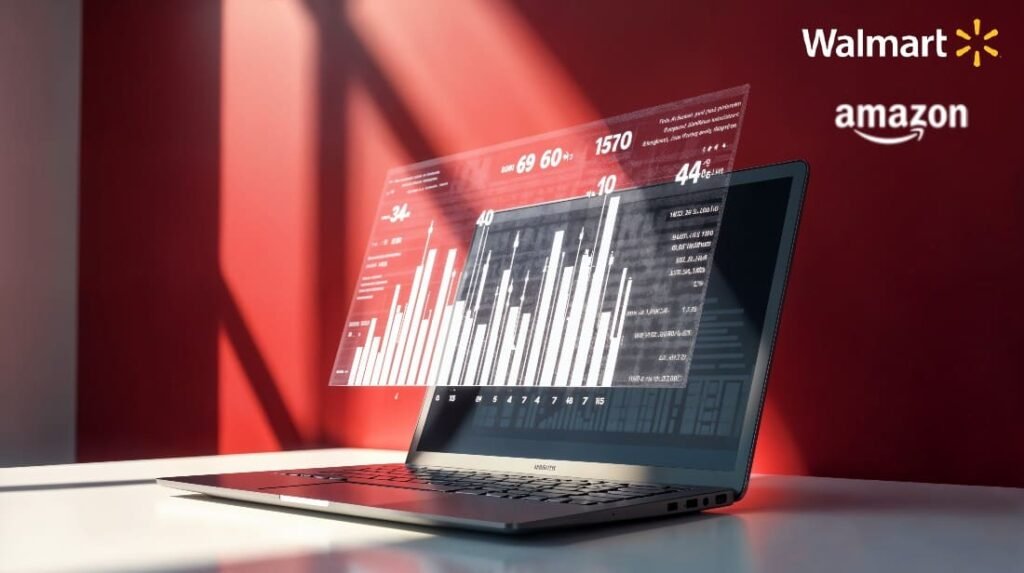
Price has become one of the most powerful elements in today’s retail landscape. Shppers in USA now a days uses tools like price trackers, mobile apps, and comparison platforms to evaluate before every purchase. In this environment, a few cents can influence conversion rates, brand loyalty, and market share.
For brands, this means pricing can no longer be static or reactive. To stay relevant and competitive, ecommerce businesses must monitor pricing change across major online marketplaces specifically Amazon and Walmart to optimize their pricing policies dynamically.
This is where eCommerce data scraping becomes important. It allows brands to extract real-time, actionable data from these platforms to compare prices accurately, identify opportunities, and gain a competitive edge.
Why Daily Price Benchmarking is Crucial for U.S. Brands
1. Price Volatility is the New Normal
Online retail is ruled by algorithmic pricing, which reacts to inventory levels, demand spikes, competitor changes, and even customer behavior. On Amazon, price of a single product can change multiple times in a single day. Walmart also adapts prices by zip code, supply chain cost, or online-only deals.
Brands need to benchmark prices daily—if not hourly—to remain competitive in this landscape.
2. It Affects Consumer Trust and Conversions
Today’s customers are used to watch multiple platforms before buying. If a customer finds your product priced lower on Amazon than your own platform or at a major competitor store, you might losing the sale or customer too. Daily price benchmarking assures price consistency across channels and helps build consumer trust.
3. Informs Marketing and Promotion Planning
Accurate price benchmarks help your brand choose the right time to launch a sale or discount. Instead of guessing, your team can align promotions with competitor strategies and optimize ROI from ad campaigns and seasonal offers.
Why Amazon & Walmart Are the Go-To Sources for Pricing Intelligence
Amazon: The King of Dynamic Pricing
Amazon has become a pricing benchmark across industries. It uses AI-powered algorithms to update prices on millions of SKUs based on:
- Competitor pricing
- Purchase frequency
- Cart abandonment rates
- Stock levels
- Demand patterns
Because Amazon is the platform where pricing wars start, monitoring it helps brands to stay one step ahead.
Walmart: The Omnichannel Powerhouse
Walmart, both online and in-store, offers a wealth of pricing insights:
- Geo-based pricing based on store ZIP codes
- Aggressive price matching policies
- Data-rich rollback and bundle strategies
- A growing presence in third party marketplace selling
Monitoring Walmart pricing can help optimize omnichannel pricing strategies and support combine in-store and online performance.
Both Amazon and Walmart share a huge portion of U.S. retail transactions, this makes them essential data sources for competitive benchmarking.
What Pricing Data Can Be Extracted from Amazon & Walmart
Using eCommerce data scraping tools or APIs, brands can extract structured, ready-to-use pricing data across thousands of products. Key elements include:
Real-Time Product Pricing
- MSRP, sale price, and dynamic price history
- Bundle pricing and quantity discounts
- Time-sensitive offers (e.g., Lightning Deals on Amazon)
Stock and Availability
- In-stock/out-of-stock status
- Low inventory alerts
- Backorder insights
Seller Identification
- Whether the seller is 1P (Amazon/Walmart), 3P, or fulfilled by marketplace
- Analysis of gray market or unauthorized sellers affecting MAP
Location-Specific Pricing
- Prices that differ by ZIP code, state, or store
- Useful for hyper-local promotions and inventory allocation
Product Metadata
- Reviews and ratings
- Shipping cost and delivery speed
- Bestseller rank (BSR) on Amazon or top trending on Walmart
With regular updates, this data powers daily pricing dashboards and automated alerts to support proactive decision-making.
How U.S. Brands Use Pricing Data for Benchmarking
1. Tracking Competitor Price Changes
With daily scraped data, brands can automatically detect:
- New product launches
- Sudden price drops
- Competitor promotions
- Seasonal sales patterns
This enables fast, reactive pricing moves and promotion matching.
2. Maintaining MAP Compliance
Scraping price data across Amazon and Walmart helps detect violations of your Minimum Advertised Price (MAP) policy. Brands can:
- Identify rogue sellers
- Issue take-down notices
- Maintain brand value and retail partner trust
3. Optimizing Profitability with Dynamic Pricing
With historical and real-time pricing insights, brands can build their own dynamic pricing models that adjust prices based on:
- Competitor trends
- Stock levels
- Time of day
- Demand surges
This helps optimize margins while remaining competitive.
4. Planning Promotions and Discounts
Instead of blanket markdowns, use benchmark data to:
- Time deals based on competitor actions
- Bundle products for higher perceived value
- Test pricing thresholds using A/B comparisons
5. Matching Products Across Marketplaces
Using product matching algorithms, brands can link equivalent SKUs across Amazon, Walmart, and their own D2C channels to maintain consistency in:
- Pricing
- Naming
- Imagery and specifications
This provides a 360° view of pricing across the eCommerce ecosystem.
Real-World Use Cases: How Brands Win with Daily Pricing Intelligence
National Food Brand Benchmarking Snack Prices
The brand tracked its top-selling SKUs on both Amazon Fresh and Walmart Grocery. It discovered that Walmart’s private label competitor was priced 8% lower in the Midwest. The brand launched a targeted rebate campaign and maintained volume while preserving margin.
Apparel Retailer Synchronizing Seasonal Promotions
By scraping data daily from Amazon and Walmart Fashion, this brand matched competitor markdowns during the back-to-school season. Result: +18% sales and improved sell-through of older inventory.
Consumer Electronics Brand Tracking Accessory Bundles
Using eCommerce scraping, the brand analyzed how Amazon 3P sellers bundled chargers with devices. They replicated the strategy, bundled their accessories, and reduced cart abandonment on Walmart by 30%
How It Works: The Power of eCommerce Data Scraping
eCommerce data scraping involves automated crawlers that collect structured data from websites like Amazon and Walmart, allowing for:
- High-frequency updates
- Large-scale product coverage
- Reliable and actionable insights
At DataSeeders, we provide:
- Real-time and scheduled scraping solutions
- Custom dashboards for pricing intelligence
- AI-based product matching systems
- Geo-pricing and MAP enforcement tools
- Ethical and compliant scraping infrastructure
Explore our eCommerce Data Scraping Services
Challenges to Consider
While the value is immense, pricing intelligence isn’t plug-and-play. Challenges include:
Anti Scraping Systems: Amazon and Walmart have sophisticated protection. Use rotating IPs, headless browsers, and human like scraping process.
Data Freshness: In fast moving categories, even 24 hour old data is outdated. Use hourly scrapes for sensitive SKUs.
Product Matching Complexity: Similar SKUs may differ slightly in attributes. Use NLP and image analysis to ensure accuracy.
Legal Compliance: Follow platform terms and regional data regulations. Work with ethical data providers only.
The Benefits: Smarter, Faster, Better Decisions
- Grow Sales with optimized pricing
- Protect Margins through smarter promotions
- Boost Visibility on marketplaces via price-performance balance
- Reduce Time to Market for pricing decisions
- Increase Agility in responding to competitor shifts
Conclusion: Benchmark Boldly or Risk Falling Behind
In a digital retail economy, you cannot afford to make pricing decisions in assumption. By accessing Amazon and Walmart pricing data, eCommerce brands in USA can have greater clarity over competitor tactics, consumer behavior, and real-time trends.
With the help of eCommerce data scraping, you can automate this intelligence and transform your pricing strategy into a revenue engine.
Want to Benchmark Like a Market Leader?
Partner with DataSeeders for real-time, scalable, and compliant data extraction from Amazon, Walmart, and beyond.
Get a Free Demo or Quote Today – sales@dataseeders.com




